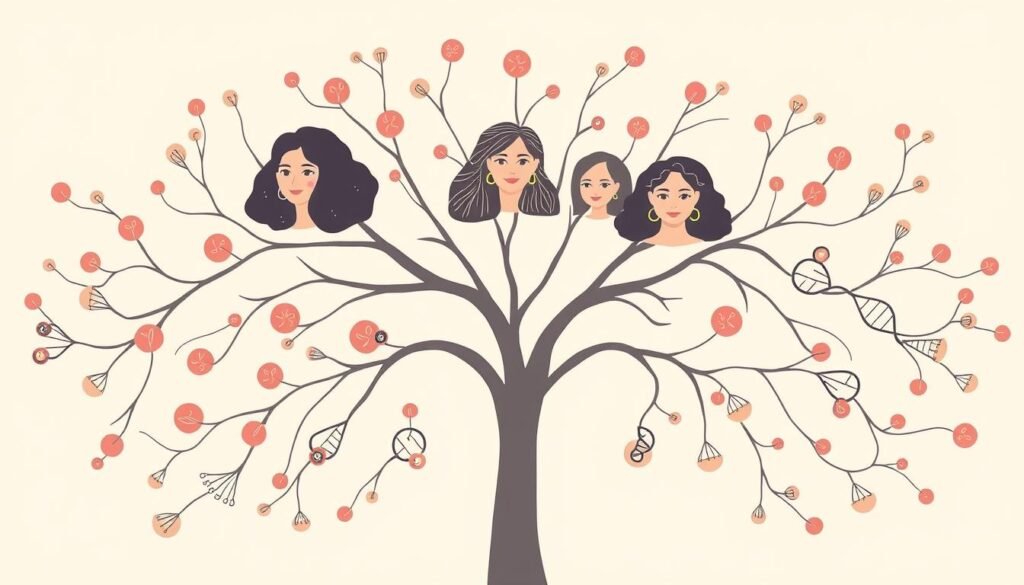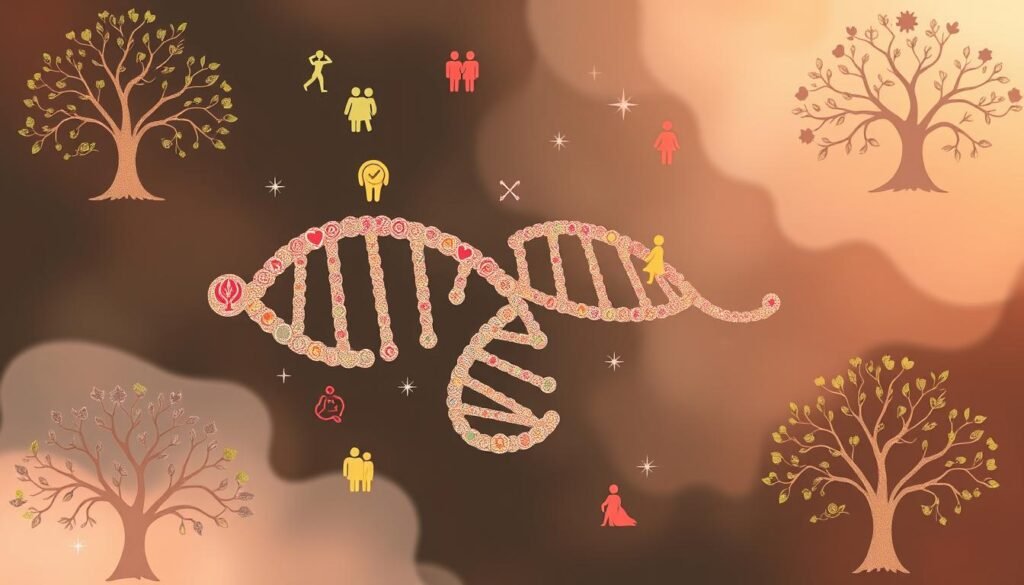About 12% of women at reproductive age struggle with polycystic ovary syndrome (PCOS). This common condition is an endocrine disorder that’s often not diagnosed early enough. It affects more than just fertility, including metabolism and hormone levels. Knowing if PCOS runs in your family is important for understanding your own health risks.
Studies show that genetics play a key role in PCOS. Looking into your family’s health history can offer clues for managing and treating it. For more on this, check the article from the National Institutes of Health. It discusses the genetic factors of PCOS in depth.
Key Takeaways
- PCOS affects approximately 12% of women of reproductive age.
- Family history plays a significant role in determining genetic predisposition to PCOS.
- Identifying genetic links can help manage and treat PCOS effectively.
- Elevated hormone levels are commonly seen in women diagnosed with PCOS.
- Understanding fecundity issues in conjunction with metabolic concerns is vital.
- Genetic testing can illuminate a person’s risk for developing PCOS.
The Basics of PCOS
Polycystic Ovary Syndrome (PCOS) is a disorder that affects about 8-13% of women who can have babies. It has symptoms like irregular periods, high levels of male hormones, and many cysts on the ovaries. Women with PCOS may also see more hair growth, acne, and weight gain. This syndrome is a big reason why some women can’t get pregnant.
Knowing the basics of PCOS is key to managing it well. Sadly, up to 70% of women with this condition don’t even know they have it. This can lead to serious health problems over time. Women with PCOS are more likely to get diabetes, high blood pressure, high cholesterol, and heart disease. They can also get cancer in the lining of the uterus. It’s very important to be aware of these risks for better women’s health.
To diagnose PCOS, doctors look for at least two signs. These are symptoms of high male hormones, irregular or no periods, or many cysts on the ovaries seen during an ultrasound. Blood tests might show hormone levels that are typical for PCOS.
There is no cure for PCOS, but treatments can help with symptoms like irregular periods, trouble getting pregnant, acne, and too much hair. Making changes like exercising more and eating better can really help. For tips on living with PCOS, check out this resource.
| Symptom | Description |
|---|---|
| Irregular Menstrual Cycles | Periods that are not regular, often more than 35 days apart, or not at all. |
| Hyperandrogenism | Having lots of male hormones, which can lead to a lot of hair growth and acne. |
| Polycystic Ovaries | Many small cysts on the ovaries, which can be seen in an ultrasound. |
| Infertility | Having a hard time getting pregnant, mainly because of not ovulating. |
| Metabolic Issues | A higher risk of things like insulin resistance, being overweight, and more metabolic problems. |
Understanding Family History and Genetic Predisposition to PCOS
Family history plays a big role in the risk of getting polycystic ovary syndrome (PCOS). Studies have found that up to 70 percent of daughters with mothers who have PCOS might get it too. This shows a strong family connection. Even though genetics are a factor, environment and lifestyle are also key in this complex disorder.
The Role of Genetics in PCOS Development
About 1 in 10 women of childbearing age are affected by PCOS. This makes it a common endocrine disorder. Genetics don’t explain all about PCOS, as they account for less than 10% of its heritability. The way PCOS shows up differently in family members makes it hard to pinpoint a genetic cause. Factors beyond our genes, called epigenetic influences, play a part too, making it even more complicated.
Examining Family Medical Records
Looking at family medical records helps us see patterns of PCOS and related health issues. If there’s a history of high blood pressure or heart disease in your family, you might be more at risk for PCOS. Checking these records early on can help with better treatment outcomes. For more in-depth knowledge, check out this resource on family ties to PCOS.
Signs and Symptoms of PCOS
PCOS symptoms vary widely among women, making early detection and management key. It’s known that reproductive, metabolic, and hormonal signs often point to this disorder. Understanding these symptoms is crucial for early diagnosis and treatment.
Reproductive Symptoms and Their Clinical Significance
Reproductive issues are at the forefront of PCOS signs. One common sign is having irregular menstrual cycles. Women may also face:
- Irregular or absent periods
- Infertility issues
- Excess body hair (hirsutism)
- Acne and oily skin
These symptoms, stemming from high androgen levels, are key to recognizing PCOS. To diagnose, two of these symptoms are usually required: irregular periods, high androgen levels, or polycystic ovaries. It highlights the importance of knowing these reproductive signs for clinical diagnosis.
Metabolic and Hormonal Indicators
PCOS isn’t just about reproductive symptoms. Many women show signs of insulin resistance, too. This condition can raise insulin levels, making obesity and greater androgen production more likely. Alongside this, signs such as:
- High blood pressure
- Abnormal lipid profiles
- Dark patches of skin (acanthosis nigricans)
are linked with PCOS. They increase the risk of type 2 diabetes and metabolic syndrome. Recognizing both metabolic and reproductive symptoms is key to treating this complex disorder effectively.

Hereditary PCOS: The Evidence
Studies show PCOS often runs in families. Many genetic studies suggest it may follow an autosomal dominant pattern. This means it involves several genes, not just one.
Statistics on Familial Occurrence
Between 15-20% of women of reproductive age worldwide have PCOS. This high number points to a genetic connection, especially in those with a family history. The genes related to steroid hormone production might be involved. However, findings vary due to the lack of standard diagnostic criteria.
Case Studies Supporting Genetic Links
Family stories and case studies back up the idea of PCOS being hereditary. If PCOS is in the family, members often show similar symptoms. Yet, how these symptoms appear can vary greatly. This is due to both genetic and environmental factors.
The study of genes involved in PCOS reveals a complex picture. Over 500 genes and numerous genetic markers have been linked to PCOS. This complexity makes it hard to pinpoint how genetics contribute to the condition. Thus, studying PCOS in families is crucial for understanding it better.

| Factor | Details |
|---|---|
| Prevalence | 15-20% of reproductive women affected by PCOS |
| Inheritance Pattern | Autosomal dominant inheritance suggested |
| Genes Identified | 533 potential genes associated with PCOS |
| Common Variants | 5170 variants identified in clinically important exomes |
| Unique Variants in Lean PCOS | 4 unique variants found |
| Unique Variants in Obese PCOS | 2 unique variants found |
Genetic Risk Factors Associated with PCOS
Polycycstic Ovary Syndrome (PCOS) affects about 10 percent of women. This shows how important it is to understand the genetic risk factors. Studies show that women related to someone with PCOS have a higher chance of getting heart and metabolic diseases. This suggests a link between genetic factors and PCOS.
A study looked at the polygenic risk score (PRS) for 176,360 men in the U.K. Biobank. High-risk scores were linked to more cases of heart disease, type 2 diabetes, baldness, and obesity in these men. In fact, an increase in PRS was tied to a 9 percent higher risk of obesity.
Having family members with PCOS, like a mother, sister, or aunt, means you might have it too. Between 20-40 percent of those with a family history of PCOS share this condition. Also, treating and diagnosing PCOS was very expensive, costing about $8 billion in 2020.
About 6-12 percent of people who can have babies, those aged 15 to 44, are found to have PCOS. While most are diagnosed in their 20s and 30s, the criteria for diagnosing PCOS can vary. This condition is a major reason why some women struggle to have children.
Insulin resistance is common in those with PCOS, especially if they are overweight or have diabetes in the family. Not being active enough can increase the risk of PCOS. Plus, high anti-Mullerian hormone (AMH) levels are seen in PCOS cases. But, high AMH alone doesn’t confirm PCOS.

| Research Findings | Statistics |
|---|---|
| Female first-degree relatives with PCOS | Higher rates of cardiometabolic disease |
| PCOS prevalence in reproductive-age individuals | 6%-12% (possible range of 4%-21%) |
| Cost of diagnosing and treating PCOS in 2020 | $8 billion |
| Odds of obesity increase per standard deviation in PRS | 9% |
| Percentage of individuals with PCOS who also have affected family members | 20%-40% |
Ancestral Health Patterns in PCOS Cases
Looking into the health patterns of our ancestors gives us clues about Polycystic Ovary Syndrome (PCOS). We know a lot about PCOS because of genetics. These genetics affect our family’s health through many generations. By understanding these patterns, we can see how family history shapes our health, especially with PCOS.
How Family History Shapes Health Outcomes
Our family’s health history is very important when it comes to PCOS. Studies have shown that PCOS often runs in families. In fact, about half of all sisters of someone with PCOS will also show signs of it. This shows how our ancestors’ health can affect our chances of developing PCOS. The condition’s presence in different ethnic groups also shows the importance of our genetic background.
- Prevalence of PCOS varies based on ancestry, with some ethnic groups displaying increased incidence.
- Studies have identified specific genetic loci associated with PCOS risk across diverse populations.
- Shared environmental and lifestyle factors among families might affect health outcomes.
Research on PCOS shows that its prevalence remains steady, even as obesity increases worldwide. This tells us that genetics and ancestral health patterns play a big role in understanding PCOS. As we learn more from research, we can better address health issues that run in families. This will help us come up with more specific ways to manage and treat conditions like PCOS.
| Ethnicity | PCOS Prevalence Rate |
|---|---|
| Caucasian | 4% – 6.5% |
| African American | Comparable to Caucasian |
| South Asian | 8.8% – 9.13% |
| Spanish Caucasian | 6.5% |
| Pakistan | 40% – 50% |
| China | 5.6% |
Multigenerational PCOS Trends
Looking into the multigenerational trends of polycystic ovary syndrome (PCOS) helps us understand its complex nature. It shows how genes and environment work together, affecting families over generations. By studying these links, we can find better ways to prevent and treat PCOS.
Insights from Family Genealogies
Family histories give us clues about the chances of having PCOS. If PCOS is common in a family, the risk goes up for others in that family. This shows PCOS can be passed down through genes. Knowing which genes are involved helps researchers study PCOS further. This can lead to better risk assessments for families.
Cross-Generational Health Studies
Studies across generations show that certain lifestyles and environments can affect PCOS risks. These findings tell us that choices and surroundings can impact health over generations. The rates of PCOS vary, with some ethnicities and places seeing more cases than others. Obese individuals make up nearly half of those with PCOS, showing the need for specialized help based on family history.
Learning more about genetic factors is crucial. It helps tailor healthcare to fit different cultural needs. Read more about these genetic studies.
| Generation | Prevalence of PCOS | Associated Health Risks |
|---|---|---|
| First Generation | 10% – 15% | Insulin Resistance, Obesity |
| Second Generation | 15% – 21% | Type 2 Diabetes, Metabolic Syndrome |
| Third Generation | Up to 20% | Anxiety, Depression |
Understanding the connection between family genealogies and health is key in tackling PCOS. This insight highlights the role of healthcare in considering family history for managing PCOS-related health issues.
Inherited Hormonal Imbalances and Their Impact
Inherited hormonal imbalances play a key role in Polycystic Ovary Syndrome (PCOS). Women with PCOS often have higher androgen levels. This can affect their reproductive health significantly. Challenges such as infertility and a higher risk of endometrial cancer are common. This shows the strong PCOS impact on women’s health.
Genetic, endocrine, and environmental factors contribute to PCOS. High androgen levels during pregnancy may cause early PCOS signs in teens. Also, daughters of women with PCOS may have a higher risk of developing it. This is due to early adrenarche, leading to common PCOS symptoms as they age.
It is vital to understand these hormonal imbalances for better PCOS care. Recognizing these patterns helps doctors provide better support for women. Good sleep hygiene helps balance hormones and promotes a healthier lifestyle. For tips on improving sleep, visit this resource.